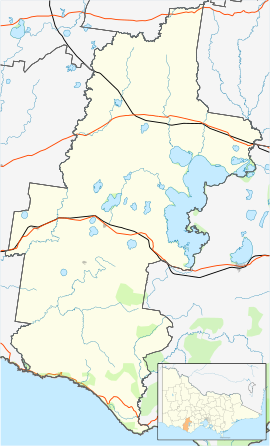Camperdown, Victoria
|
Camperdown Victoria |
|||||||
|---|---|---|---|---|---|---|---|

Manifold Street Camperdown looking east toward the clock tower and war memorial
|
|||||||
| Location in the Shire of Corangamite | |||||||
| Coordinates | 38°14′S 143°09′E / 38.233°S 143.150°ECoordinates: 38°14′S 143°09′E / 38.233°S 143.150°E | ||||||
| Population | 3,463 (2011 census) | ||||||
| Established | 1854 | ||||||
| Postcode(s) | 3260 | ||||||
| Elevation | 165 m (541 ft) | ||||||
| Location |
|
||||||
| LGA(s) | Corangamite Shire | ||||||
| State electorate(s) | Polwarth | ||||||
| Federal Division(s) | Wannon | ||||||
|
|||||||
Camperdown /ˈkæmpədaʊn/ is a historically significant rural town in southwestern Victoria, Australia, 194 kilometres (121 mi) west of the state capital, Melbourne. At the 2011 census, Camperdown had a population of 3,463.
The Djargurd Wurrung people are the traditional Aboriginal people of the Camperdown area, who had lived in the area for tens of thousands of years as a semi-nomadic hunter gatherer society.
The first British settlers, the Manifold brothers, arrived in the area from Van Diemen's Land (Tasmania) after 1835 to establish sheep runs. They quickly changed to cattle. In 1836, it is estimated that 35 - 40 indigenous people from the Tarnbeere Gundidj clan of the Djargurd Wurrung were killed in the Murdering Gully massacre. The Manifold's employed the local tribemen because the white stockmen had quit and tried their luck at the Ballarat goldfields. Notable on this account is the family of David Fenton, the Scottish Presbyterian shepherd and drover who built the first house in Camperdown in 1853.
In 1883 Wombeetch Puuyuun (also known as Camperdown George) died at the age of 43 and was buried in a bog outside the bounds of Camperdown Cemetery. His friend, James Dawson was shocked at this burial upon his return from a trip to Scotland, and personally reburied Wombeetch in Camperdown Cemetery. He appealed for money to raise a monument, but with little public support, primarily funded the monument himself. The 7 metre obelisk was erected as a memorial to Wombeetch Puuyuun and the aborigines of the district, and has been described as being still inspiring today.
The town was surveyed in 1851 and named Camperdown after the Scottish naval hero Lord Viscount Adam Duncan the Earl of Camperdown. The first dwelling was erected on the site of the present Commercial Hotel in 1853 and the Post Office opened on 1 January 1854 replacing an earlier one in the area named Timboon.
...
Wikipedia

